Category Archives for Sketching
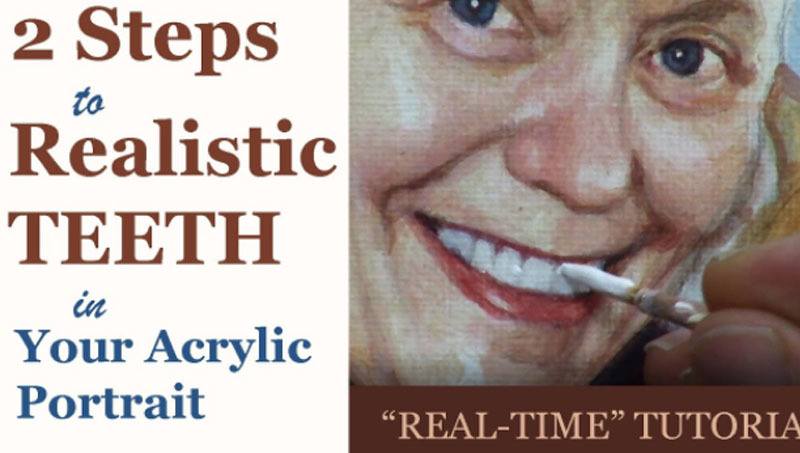
Two Steps to Make Teeth More Realistic in Your Acrylic Portrait
What colors do you use for shadows in your acrylic portrait?
Cooler colors really can help to add the realism you are aiming for. In this brief tutorial video, using a commissioned portrait as an example, I’ll show you what colors to mix and why.
- Adding highlights to your acrylic painting
- 5 Excellent Reasons to Use Aluminum Foil
- Paint Realistic Wrinkles in Acrylic
- Painting Clothing in an Acrylic Portrait
- Paint a Cloudy Sky Acrylic
- How to add Semi-Opaque Highlights
- How to Enhance the Contrast in Your Acrylic
- How to Add Glaze to Your Acrylic Painting
- Paint Realistic Reflections on Eyeglasses in an Acrylic Portrait
- Build Up Depth on Your Acrylic Portrait Backgrounds
- How Do You Do Layers With the Glazing Technique?
- Learn How to Paint Wrinkles in Acrylic
Read more about how to paint a portrait that you can surely be proud of!
I’d love to hear your thoughts on this video. Please share it with your friends and family. Let me know if you have any further questions. I’ll greatly help you.
If you’d like to learn more, sign up for my free email tips and video class today.
Learn How to Paint Acrylic Portraits With My Free Mini-Video Course!
Thank you so much for taking the time to read this tutorial and watch the video. That means a lot to me. I hope you find it very helpful in your portrait painting.
Yours for Better Portraits,

P.S. Did you find this post helpful or encouraging? If so, send it on ahead! Let others know with the share buttons below. I’d love to hear your comments. Thank you so much! Also, do you have a question on acrylic portrait painting you’d like answered? Let me know, and I’d be happy to help!
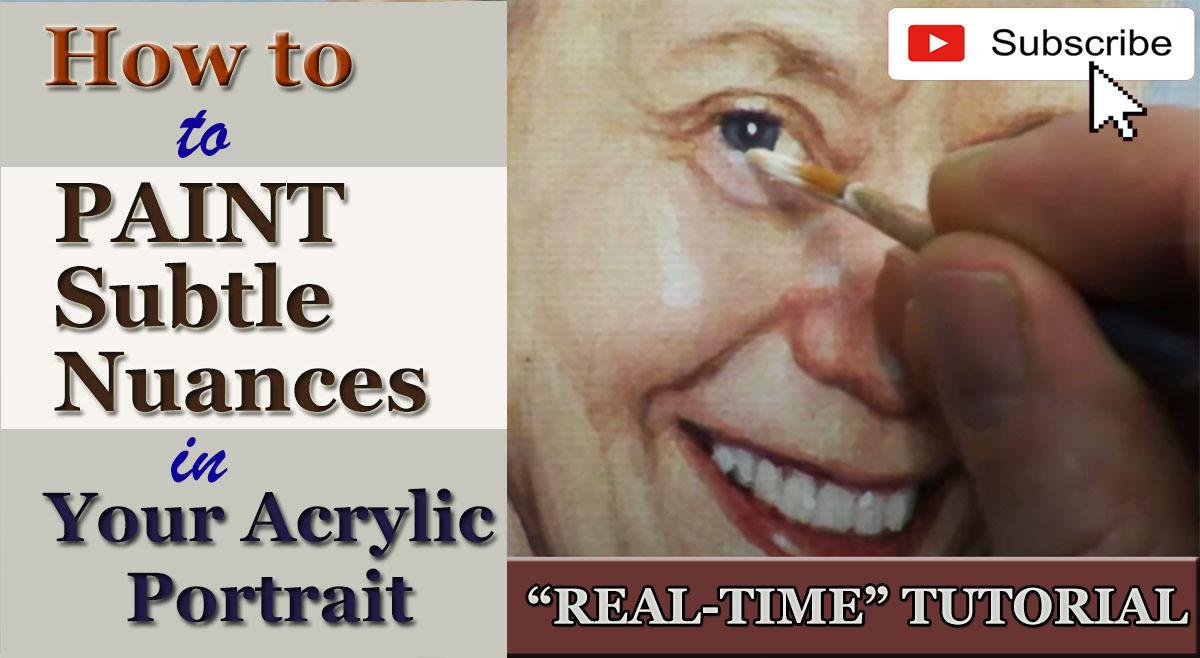
How to Paint Subtle Nuances in Your Acrylic Portrait
It’s those final nuances and details that can really make a portrait look realistic.
In this video, I’ll show you how to add a highlight to the eyelid, a nuance to the nose and cheek, and a few details of the hair. When you learn how to do this correctly, you too, can finish your painting well and create a portrait you can be proud of!
- Adding highlights to your acrylic painting
- 5 Excellent Reasons to Use Aluminum Foil
- Paint Realistic Wrinkles in Acrylic
- Painting Clothing in an Acrylic Portrait
- Paint a Cloudy Sky Acrylic
- How to add Semi-Opaque Highlights
- How to Enhance the Contrast in Your Acrylic
- How to Add Glaze to Your Acrylic Painting
- Paint Realistic Reflections on Eyeglasses in an Acrylic Portrait
- Build Up Depth on Your Acrylic Portrait Backgrounds
- How Do You Do Layers With the Glazing Technique?
- Learn How to Paint Wrinkles in Acrylic
Read more about how to paint a portrait that you can surely be proud of!
I’d love to hear your thoughts about this video. Please share it with your friends and family. Let me know if you have any further questions. I’ll greatly help you.
If you’d like to learn more, sign up for my free email tips and video class today.
Learn How to Paint Acrylic Portraits With My Free Mini-Video Course!
Thank you so much for taking the time to read this tutorial and watch the video. That means a lot to me. I hope you find it very helpful in your portrait painting.

P.S. Did you find this post helpful or encouraging? If so, send it on ahead! Let others know with the share buttons below. I’d love to hear your comments. Thank you so much! Also, do you have a question on acrylic portrait painting you’d like answered? Let me know, and I’d be happy to help!
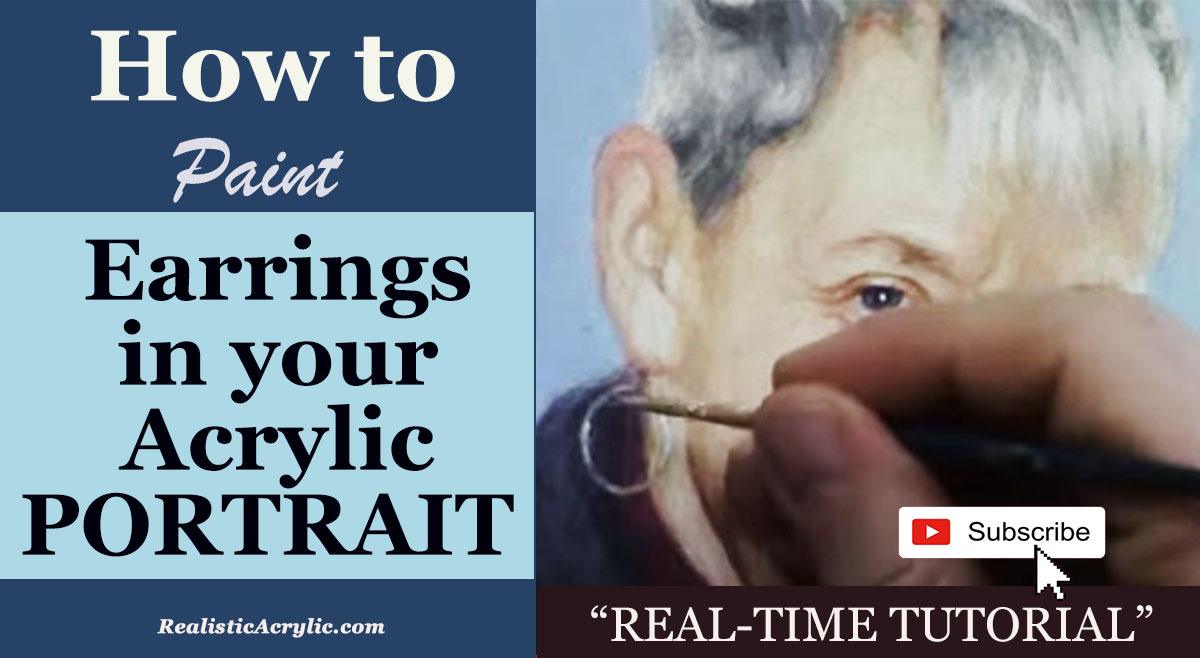
How to Paint Earrings in Your Acrylic Portrait
Earrings are an often neglected detail on an acrylic portrait.
In this video, I’ll show you how to paint earrings, especially the highlights.
Watch my free tutorial to learn more on how to paint earrings in your acrylic portrait.
- Adding highlights to your acrylic painting
- 5 Excellent Reasons to Use Aluminum Foil
- Paint Realistic Wrinkles in Acrylic
- Painting Clothing in an Acrylic Portrait
- Paint a Cloudy Sky Acrylic
- How to add Semi-Opaque Highlights
- How to Enhance the Contrast in Your Acrylic
- How to Add Glaze to Your Acrylic Painting
- Paint Realistic Reflections on Eyeglasses in an Acrylic Portrait
- Build Up Depth on Your Acrylic Portrait Backgrounds
- How Do You Do Layers With the Glazing Technique?
- Learn How to Paint Wrinkles in Acrylic
Read more about how to paint a portrait that you can surely be proud of!
I’d love to hear your thoughts about this video. Please share it with your friends and family. Let me know if you have any further questions. I’ll greatly help you.
If you’d like to learn more, sign up for my free email tips and video class today.
Learn How to Paint Acrylic Portraits With My Free Mini-Video Course!
Thank you so much for taking the time to read this tutorial and watch the video. That means a lot to me. I hope you find it very helpful in your portrait painting.
Yours for Better Portraits,

P.S. Did you find this post helpful or encouraging? If so, send it on ahead! Let others know with the share buttons below. I’d love to hear your comments. Thank you so much! Also, do you have a question on acrylic portrait painting you’d like answered? Let me know, and I’d be happy to help!
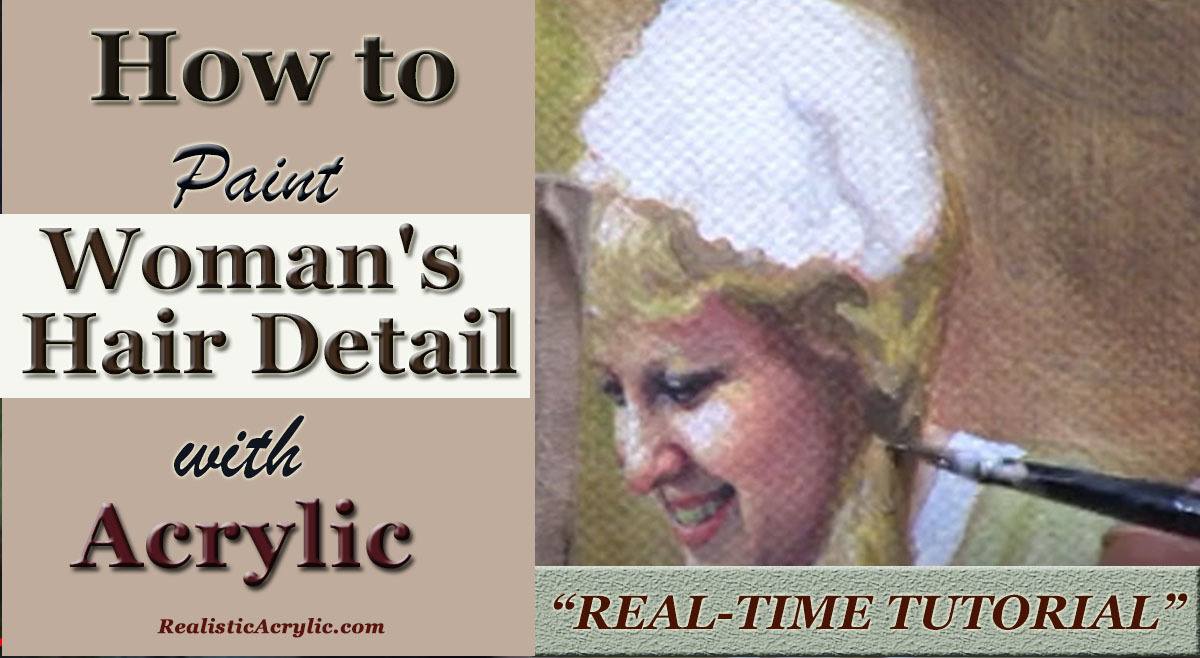
How to Paint a Woman’s Hair Detail with Acrylic
I’ll show you how I paint the details of a woman’s hair, in an acrylic portrait.
As an example, I am using a commissioned portrait I did of a couple wearing colonial garb.
Watch my free tutorial to learn more how I painted a woman’s hair detail with acrylic.
- Adding highlights to your acrylic painting
- 5 Excellent Reasons to Use Aluminum Foil
- Paint Realistic Wrinkles in Acrylic
- Painting Clothing in an Acrylic Portrait
- Paint a Cloudy Sky Acrylic
- How to add Semi-Opaque Highlights
- How to Enhance the Contrast in Your Acrylic
- How to Add Glaze to Your Acrylic Painting
- Paint Realistic Reflections on Eyeglasses in an Acrylic Portrait
- Build Up Depth on Your Acrylic Portrait Backgrounds
- How Do You Do Layers With the Glazing Technique?
- Learn How to Paint Wrinkles in Acrylic
Read more about how to paint a portrait that you can surely be proud of!
I’d love to hear your thoughts on this video. Please share it with your friends and family. Let me know if you have any further questions. I’ll greatly help you.
If you’d like to learn more, sign up for my free email tips and video class today.
Learn How to Paint Acrylic Portraits With My Free Mini-Video Course!
Thank you so much for taking the time to read this tutorial and watch the video. That means a lot to me. I hope you find it very helpful in your portrait painting.

P.S. Did you find this post helpful or encouraging? If so, send it on ahead! Let others know with the share buttons below. I’d love to hear your comments. Thank you so much! Also, do you have a question on acrylic portrait painting you’d like answered? Let me know, and I’d be happy to help!
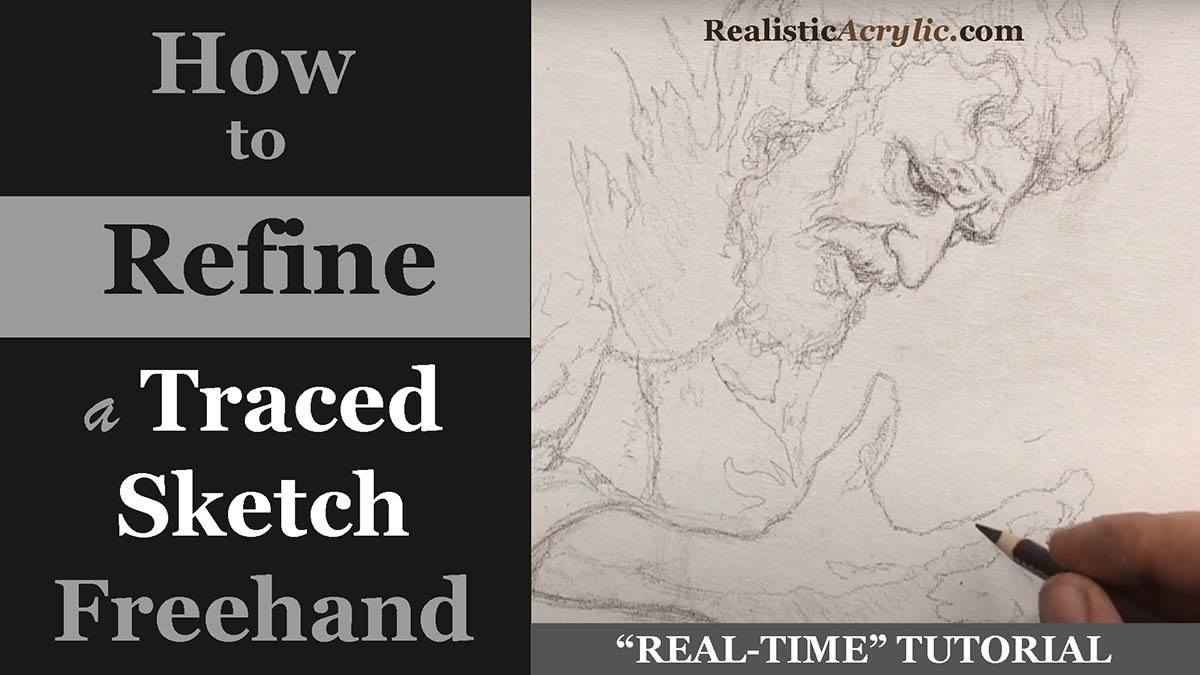
How to Refine a Traced Sketch Freehand
Ok. You just got done tracing an image for your portrait painting.
Now what? Begin painting? Not so fast! 🙂 In this video, I’ll show you how I’m refining the traced image, freehand, to make it ready to paint upon.
In this video, I’m going to work on this sketch of Isaiah or Hezekiah.
This is for the book of Isaiah by Russell Stendal and it’s an illustration based off this image here of a man in intercessory prayer. And originally, I did a video showing the tracing process, asking whether it’s ok to trace. And I think I answered that question, that it is—as long as you do freehand sketching and work with grids. But especially as you work with freehand sketching, which will help you to improve as an artist.
Now, I’m going to work in this sketch to show you the process of tightening up a sketch done by tracing initally and the tracing process does leave you with a lot of work left to be done. So, I’m going to show you how I’m going to add additional shading in detail and then have a sketch that I can paint on top of.
If you’d like to learn more, sign up for my free email tips and video class today.
Learn How to Paint Acrylic Portraits With My Free Mini-Video Course!Thank you so much for reading this tutorial and watching the video. That means a lot to me. I hope you find it very helpful in your portrait painting!

P.S. Did you find this post helpful or encouraging? If so, send it on ahead! Let others know with the share buttons below. I’d love to hear your comments. Thank you so much! Also, do you have a question on acrylic portrait painting you’d like answered? Let me know, and I’d be happy to help!
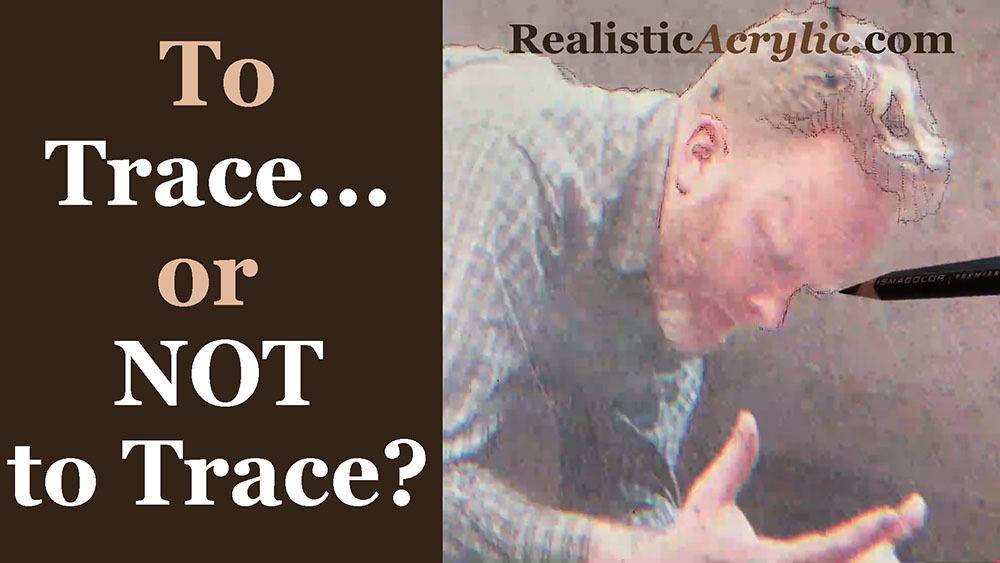
Is it OK to Trace as a Portrait Artist?
Let’s address the elephant in the room: tracing as a portrait artist. Is it OK? Is it cheating?
I’m going to answer that question today.
Up until COVID-19 hit, I participated in a Fall studio art tour every year. An artist on the tour, who was also the founder and coordinator for it, had some strong opinions about tracing.
“Matt, tell me you didn’t trace that sketch for the mural project you did.”
“I’m not going to lie,” I told her. “I did use a projector to get the proportions up, and then refine it freehand.”
“How could you do that? What if your client found out?”
“Well, first of all, this project was done for my church, as a gift,” I replied. “And secondly, I would be upfront with them if they asked about my process.”
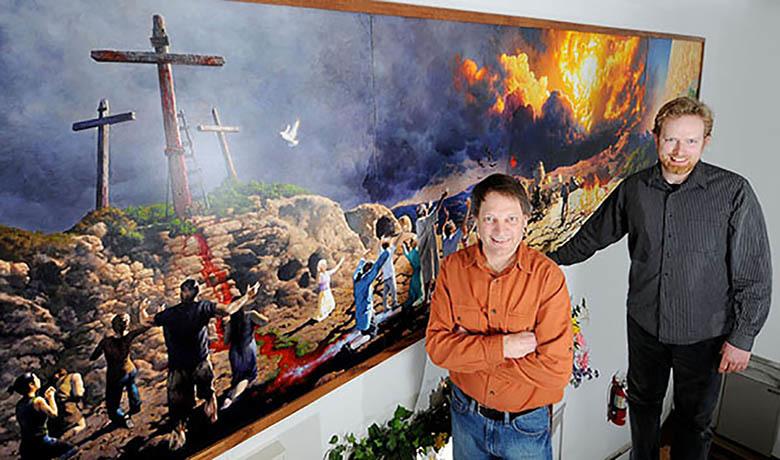
Matt Philleo and David Mattison next to the mural they created for Bethel Church, photo by Dan Reiland of Eau Claire Leader-Telegram, used with permission.
She chided me in a motherly kind of way, and I listened respectfully and smiled.
This is the first time I ever really thought about the concept of tracing as being a bad thing, at least to this degree. But is it?
I’m going to give you 5 reasons why I believe tracing is OK.
- Tracing saves time. Let’s face it. Drawing freehand, or with a grid is a time-consuming process. You have to measure, re-measure your proportions, and if you lack much drawing experience, often have to settle for eyes that are too large, noses that are unnatural, and mouths that aren’t aligned properly. I have many commissions to do, and so tracing expedites my workflow. I don’t trace all of my portraits, but for some, I choose to do so.
- Tracing helps you get accurate proportions, especially for a large painting. I had always drawn freehand and never even thought of tracing until 1999, when I did mural work with a well-known Florida muralist, Bob Jenny. He had hired me to do a series of murals depicting army medics serving in American wars at some VA hospitals. They were large—two 6′ x 30′ murals. One day, he came by to check on my work. He saw me meticulously sketching a battle scene, freehand. “We’re going to be here for months if you do it that way!” he exclaimed. “Let me show you how to do it.”And he taught me how to use an overhead projector to transfer the design up quickly and effectively.
- Tracing helps you to see distinctions in value. When you trace, especially using a projector, details become blurred and you readily notice differences in value—those distinct shapes that create the planes, the forms we see—whether they are the forehead, nose, cheekbones, or locks of hair. You can trace along the edges of those distinctions. It can be a beneficial exercise to help you in your portrait painting.
- There is historical precedent for tracing. Jan Vermeer reportedly used a camera obscura to project scenes from outside onto his surface to create exact replications of landscapes. So there is so shame. I think we can all appreciate the work of Vermeer. Art historians and art appreciators alike marvel at his skills.
- Tracing is a tool. It can be used like a contractor uses a nail gun to frame a house. The same work could be done by old-fashioned hammer and nail, but the nail-gun will do it faster. Obviously, this metaphor doesn’t translate entirely in terms of portrait painting, but the idea I’m trying to convey is that it’s just a tool.
Now, with all that said, here are some caveats on tracing.
- If you ONLY trace, and never do freehand sketching or use the grid method, your portrait painting skills will suffer. You will either stagnate, or take a very long time to progress past the beginners’ level. I get emails often from artists asking me to help them with skin tones, but because they haven’t put in the time to observe proportions and render them on the canvas, they don’t create realistic value shapes. The result is a portrait that looks falls far short of their goals. Anatomy and values must come first, skin tones after. And freehand sketching is the best way to develop it. I drew freehand for years as a child, before beginning to use acrylic in high school, and the observational skills I learned were priceless. Tracing is not cheating. But if you rely on it too much, it will cheat you, as an artist, of growth. This is why I teach my classes mostly using the grid method. It’s a good middle-of-the-road option between freehand and tracing. It helps artists create a solid sketch, so they can do a portrait they’re proud of without having to spend years getting proficient at freehand sketching. It helps them to see proportions and shapes, and then carry that confidence into their painting process!
- Tracing helps you to quickly establish proportions on your canvas, but it by itself, it’s not enough. The process often omits fine details and nuances that can only be achieved by refining your sketch with freehand sketching. In fact, tracing can flat-out distort your photo reference. In a scene, it totally obliterates the distinction between foreground and background. It can cause areas with lighter value to exceed the proper boundaries. If you want an accurate sketch to work from, you must evaluate your tracing and go back on top of it with more work, to fix mistakes and supply detail that is lacking.
- If you trace, be honest about your process. You are not obligated to tell the whole world, “I traced this!” But if your client or Facebook follower asks, did you do this freehand (most will never ask) be sure to answer them honestly and confidently about your process. If you don’t feel ashamed about it, they won’t think any less of you as an artist. Even with a traced/ projected sketch, it still takes an incredible amount of skill to do the remaining work: selecting colors, mixing them, applying them in the right places, and finishing with detail.
Here is a fun video I did on tracing. I go over a few of the ideas I shared with you above, and I also show you, if you choose to trace, how to do it, using a painting I’m doing right now as an example…
Is it OK to Trace as a Portrait Artist?
What are YOUR thoughts on tracing? Let me know below, in the comments!
Yours for Better Portraits,
Matt
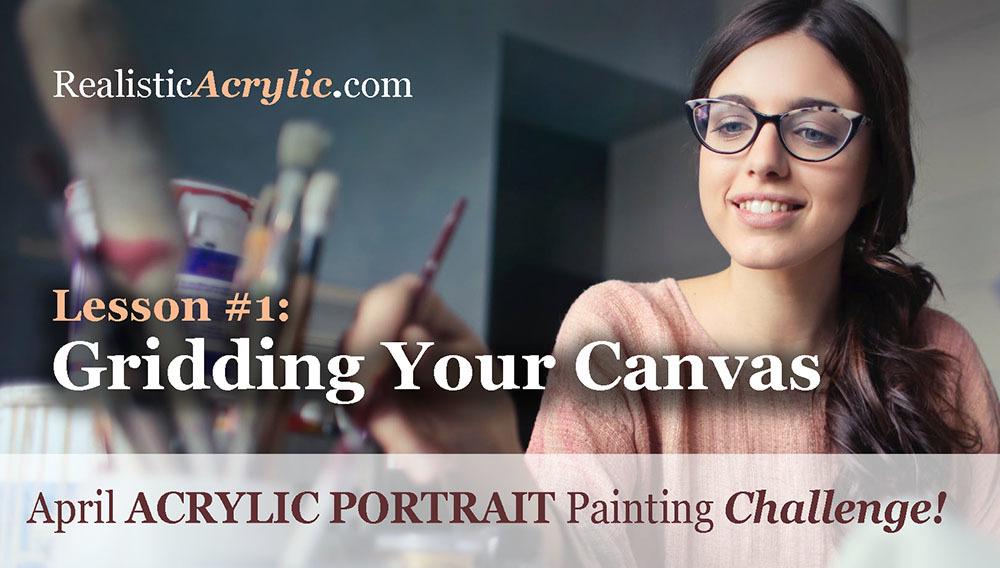
[PORTRAIT CHALLENGE] Masterclass Lesson #2: Sketching Your Portrait for a Firm Foundation
Masterclass Lesson #2 for the Acrylic Portrait Painting Challenge is open!
In this lesson, you will learn how to draw an accurate sketch that will help keep you from getting frustrated while painting. You will also be set up to create a portrait with realistic proportions, and a true likeness—where it really looks like the person you’re trying to paint.
That’s the kind of portrait you’ll be proud to show, sell, or give as an exquisite gift!
Just as a contractor wouldn’t build a house without a proper foundation, you shouldn’t paint a portrait without one either. A rock-solid sketch is the best way to establish a firm foundation for the rest of your portrait to be built upon. Take your time to do it right, and you will set yourself up for success, and avoid a lot of potential hassle later.
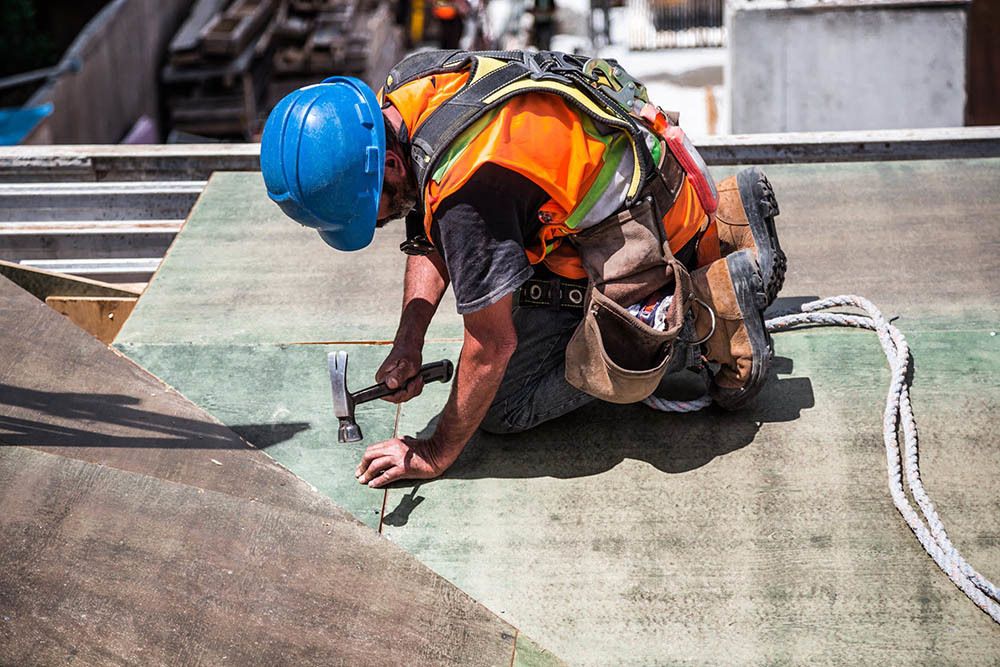
Sketching as a firm foundation for your portrait.
In our previous step, I showed you how to prepare your canvas for the sketch by creating a well-formed grid.
If you followed my instruction, you will have sealed that grid with first a layer of matte medium. Then you followed up with a roughly 50%/50% mixture of acrylic matte medium and white acrylic gesso, and let it dry for at least a couple of hours.
Now, you have a canvas that is ready to sketch upon. The matte medium/ gesso layer provides not only a barrier to the grid so you can’t erase it while sketching, but it also gives the canvas the perfect texture to sketch with a colored pencil. Back in 2017, I discovered that colored pencil erases like a dream on a properly prepared canvas. And you can seal it in without minimal loss of detail to your sketch.
Try it, and you’ll find out how fun it can be to sketch on your canvas. 🙂 You’ll never want to go back to graphite pencil again!
Another benefit: you can pick any colored pencil hue you want to match the skin tone of the subject. Remember, with my glazing technique, you will be able to see through the paint layers, down to the colored pencil until you have enough layers to cover it up. And in a few areas, even when your painting is finished, the colored pencil will shine through a bit. So pick a brown color that works best for you. Sepia, Chocolate, brown ochre, and terra cotta are all good colors for sketching.
Ready to go?
Now, before we begin…
Are you registered for the challenge?
If not, register below for FREE and I’ll send you:
- a downloadable/ printable”Welcome Kit” with a Supplies List and a Palette Color Layout Guide.
- high-resolution images of the photo we’ll be painting from for this challenge.
- each new lesson that comes out in this Masterclass series.
- a link to my private Facebook group, where you can do this challenge with other artists, get feedback and help on your portrait, and not feel alone.
REGISTER TODAY. The challenge is ongoing, something you can do at your own pace. It’s not too late to enter!
Register for the Challenge!Here’s the steps to creating a masterful sketch, a firm foundation for your painting.
- Set up your tablet (Kindle, iPad, etc) or printed reference photo next to your canvas, and display the gridded reference photo. Need something to hold your tablet up? My free course shows you how to make your own Reference Photo Holder) The reference photo is your blueprint to paint a portrait from your photo. It’s what your finished painting should look like.
- Sketch the outline first. Pay attention to where you are placing your lines. Try to see the grid squares as fractions. (“the line will intersect here at 1/4 of the way up, or 1/2 of the way over, etc”
- Fill in the features, loosely: eyes, nose, mouth, etc. The eyes are the most important feature, so really make sure you capture the shapes of not only the eyes, but the eyelids and eyebrows.
- Delineate the tonal values. Shade in the areas that are darker, and pay attention to exact forms that the shadows create. Try to think of them as abstract shapes like stretched out triangles, oblong ovals, squished rectangles, for example. As you fill in these values, the planes of the face will start to emerge. You will create a convincing sense of three-dimensional form.
- Refine your sketch and add any missing detail. Step back a bit and make sure you have the proportions correct. The grid will have done the “heavy lifting” for you, by keeping your lines pretty accurate. But you might need to erase and redraw some of the features for greater accuracy. Finish up with the wrinkles in the clothing and on the hat, if needed.
Watch my in-depth Masterclass acrylic online tutorial below to see these steps in action.
After learning from this video, You’ll know exactly how to do it.
Before you watch, I want you to know that this lesson is VERY in depth. It’s one hour long! But please, make the investment in your art talent, grab a cup of coffee or tea, and watch the whole thing. If you do, I promise that you will have greater clarity on how to begin an acrylic portrait from here on out. Every portrait you do will be that much better.
Here’s the video…
Acrylic Portrait Challenge Masterclass Lesson #2: Sketching Your Portrait for a Firm Foundation
Is it done?
How accurate does it need to be? You only need to have a likeness 90% of the way there to have a fantastic sketch.
It doesn’t have to be perfect. The painted layers will dial in the likeness the rest of the way. You don’t need to make this sketch into a drawing. Meaning, you don’t need to shade in everything to the point that it looks like a finished drawing that you could hang on your wall.
No.
The sketch is for YOUR benefit…and also that of the portrait!
It doesn’t have to amaze others at this stage. It just needs to be accurate. It needs to describe the form, the contours, the three-dimensionality of the subject with line and value. You simply need to make yourself a guide so you know where to place your glazes when you segue into the painting process.
Now the painting, when it is finished, let THAT amaze others! (and you 🙂 )
There you have it! Now you know exactly how to create a great sketch for your portrait, a firm foundation you can build the rest of your portrait upon. The next step is to seal in your sketch and ease your portrait into a painting with the first few glazes.
I’ll see you in our next class! Until then have a blessed day and use that talent God gave you to its fullest!
Yours for Better Portraits,
![]()
If you found this post helpful or encouraging, would you send it on ahead? Let others know with the share buttons below. I’d love to hear your comments. Thank you so much!
Let me know if you have any questions about the challenge that I didn’t answer. Leave your question in the comments below and I’ll get back to you!

[PORTRAIT CHALLENGE] Masterclass Lesson #1: Gridding Your Canvas for an Accurate Sketch
I’m so excited to be teaching you the first Masterclass Lesson for the Acrylic Portrait Painting Challenge!
Again, if you are taking the challenge, I commend you. It’s not easy to paint a portrait. Many artists desire to do it, but never actually begin, because it’s difficult to paint a fellow human being accurately. It’s my goal to show you how to do it, so you can paint an amazing portrait from a photo you’ll be proud to show others.
Now, you might feel like rushing this step, but I encourage you to start slowly and build a good foundation for your portrait. You’ll be glad you did.
Before we begin…
Are you registered for the challenge?
If not, register below for FREE and I’ll send you a “Welcome Kit” with a Supplies List and a Palette Color Layout Guide. I’ll also send you high-resolution images of the photo we’ll be painting from for this challenge. (It’s not too late to enter!)
Register for the Challenge!In this video lesson and tutorial, you will learn how to create a grid for your canvas. If you have several years of freehand drawing experience, you could skip this step and start sketching right away, but from my experience in teaching, most artists are not ready to do an accurate sketch for their portrait.
So, most likely, the grid method will be best for you. It allows you to create accurate proportions while still compelling you to use your hand-eye coordination and spatial perception to draw shapes and detailed forms. And that’s how I will be teaching this portrait demonstration for you.
There’s three steps to creating the grid in preparation for sketching:
- Draw it.
- Seal it.
- Mute it.
I’ll show you how, step-by-step, in this video lesson…
And now you know how to create a grid on your canvas, and you’re ready for the next step: sketching the subject! I look forward to being your guide for the rest of this adventure.
I’ll see you in our next class! Until then…
Yours for Better Portraits,
![]()
If you found this post helpful or encouraging, would you send it on ahead? Let others know with the share buttons below. I’d love to hear your comments. Thank you so much!
Let me know if you have any questions about the challenge that I didn’t answer. Leave your question in the comments below and I’ll get back to you!
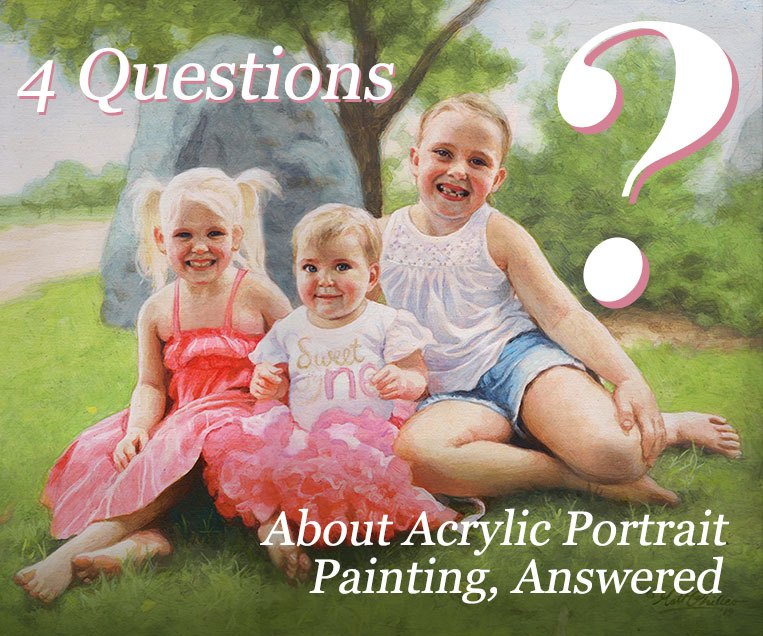
4 Questions About Acrylic Portrait Painting, Answered
Recently, I was asked some questions about acrylic portrait painting. I hope the answers I shared with this artist can be of help to you as well.
1. How do you prepare your canvas panel for painting with Acrylics?
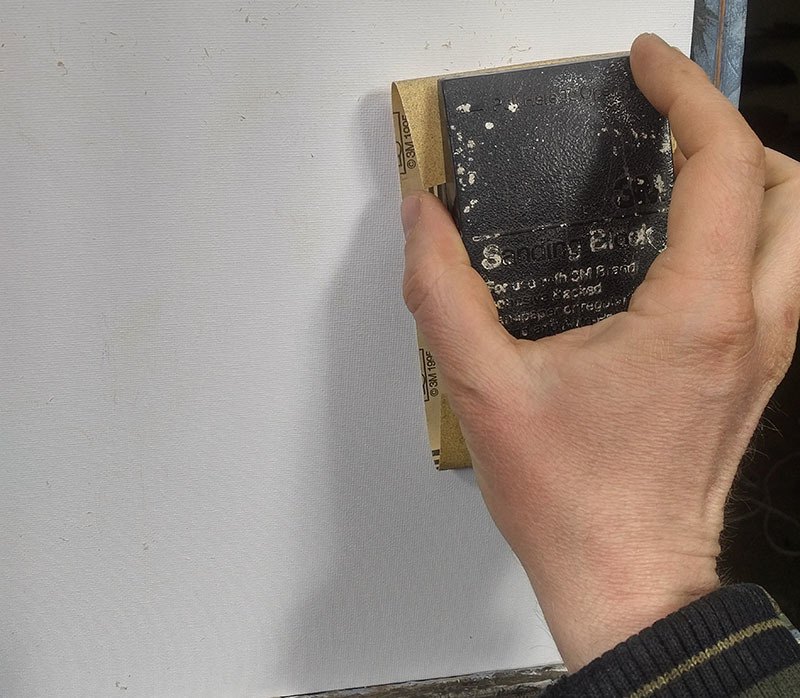
Sanding a canvas panel in preparation for painting an acrylic portrait
2. You spoke of layering your paint when composing a portrait. Please briefly explain.
I use the glazing technique to slowly bring the portrait from a white canvas to completion. The glazing technique is achieved by mixing your paint with clear acrylic medium (usually matte medium) to disperse the pigment, thus allowing light to pass through.
Although you could use water, it’s not recommended, because it breaks down the acrylic resin binder, causing a rough visual texture and possible poor adhesion. For a smoother look, you want to use clear acrylic medium.
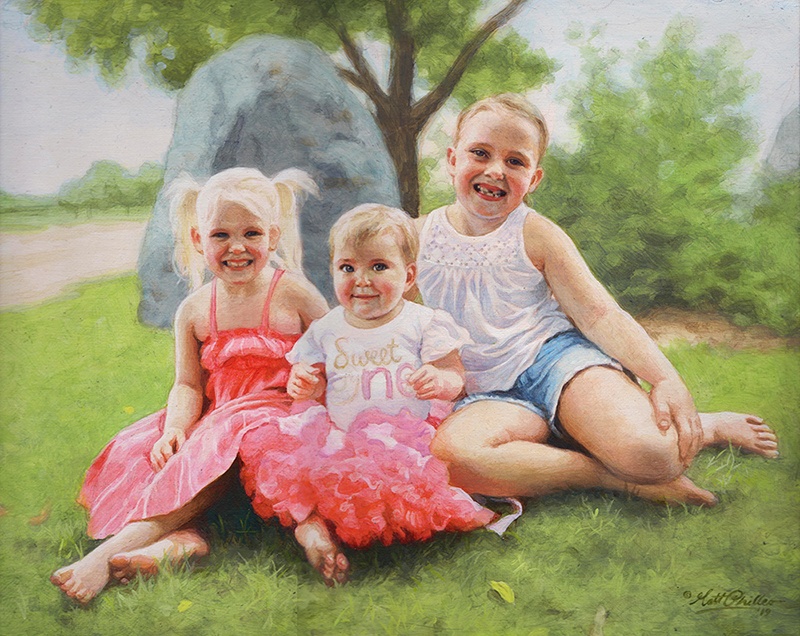
Custom commissioned realistic acrylic portrait from a photo painted by Eau Claire area artist Matt Philleo, ©2019 Fine Art by Matt Philleo
3. You mentioned using a Prismacolor pencil for making your diagram. What color do you recommend?
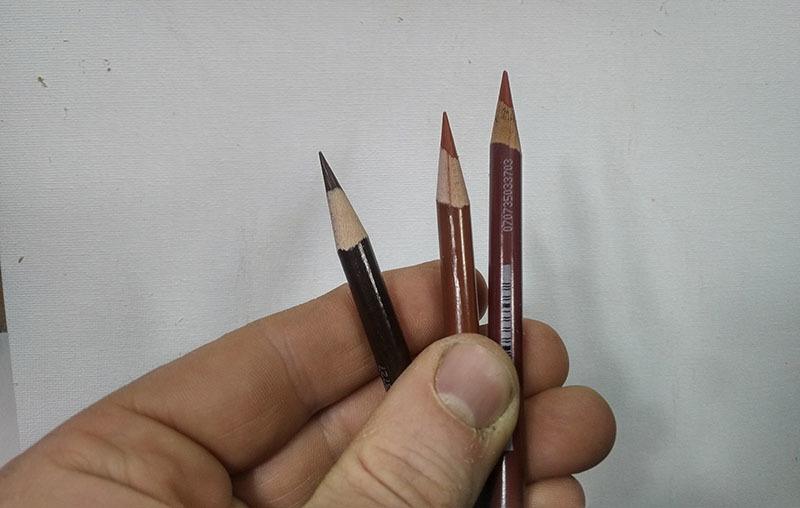
Using colored pencil for your acrylic portrait sketch makes things a lot easier. Technique discovered and developed by Matt Philleo.
4. Do you do the painting from start to finish in one setting?
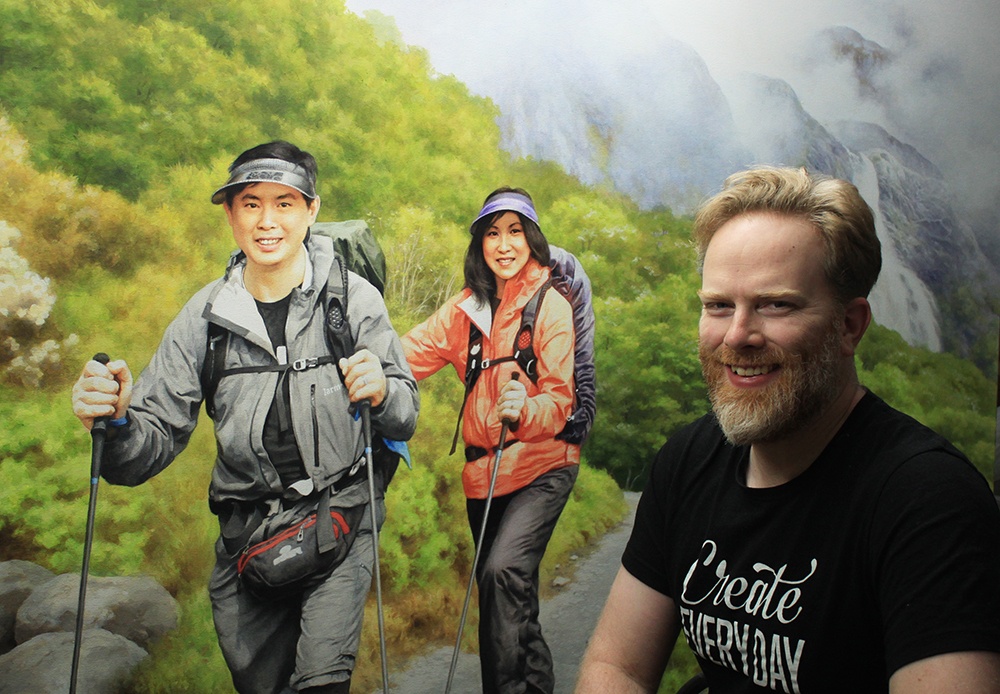
Acrylic portrait artist Matt Philleo posing in front of a 48″ x 72″ commission painting for a client in Brunei
I hope these questions and answers were helpful to you as well. I know some of this stuff seems pretty basic, but it’s good for all of us to pause and think about why we do what we do. It then makes the doing that much more significant.
Let me know if you have any questions of your own about acrylic portrait painting and I’ll do my best to help!

P.S. Did you find this post helpful or encouraging? If so, send it on ahead! Let others know with the share buttons below. I’d love to hear your comments. Thank you so much! Also, do you have a question on acrylic portrait painting you’d like answered? Let me know, and I’d be happy to help!
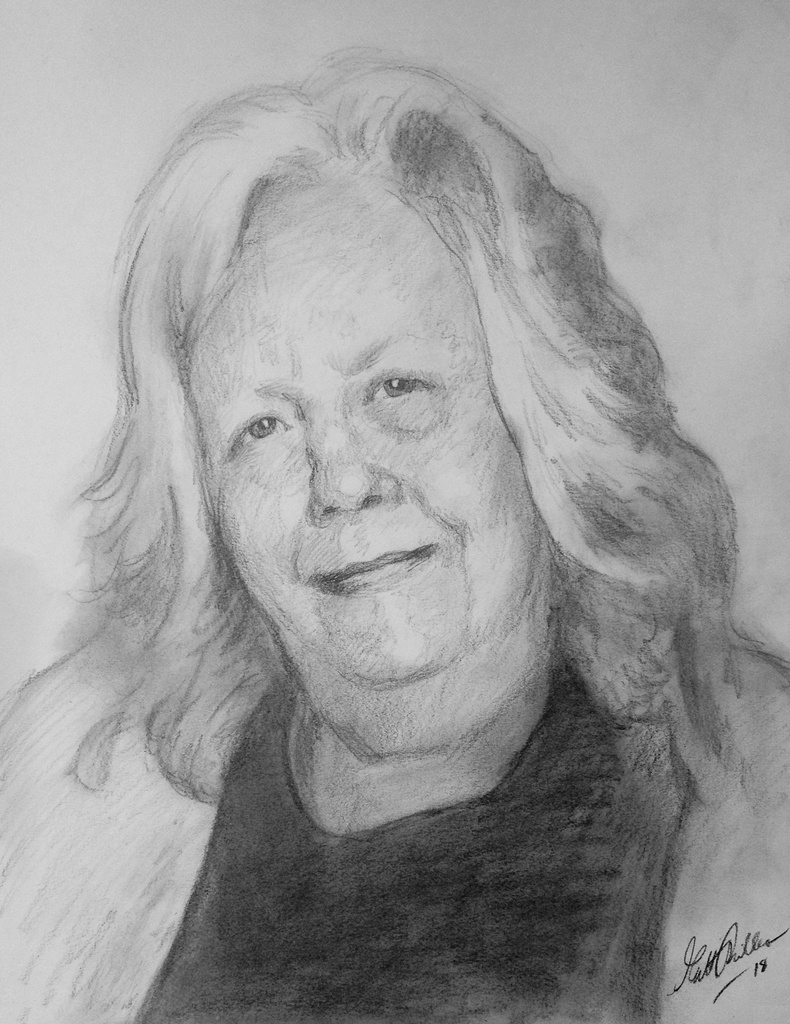
How Freehand Sketching Can Improve Your Painting
What is the best way to get better as an acrylic portrait artist?
Is it by learning a new skin tone recipe? Is it by getting a new glazing medium? Or is it by watching a bunch of time-lapse videos?
All of these things can help, but what will get you the fastest results is to go to the foundation: accurate drawing. Most painters spent months or even years doing drawings before ever picking up a paintbrush. There’s just something about drawing that works wonders for your painting skills.
I think part of it is that it bypasses the other concerns of handling paint: mixing colors, brush technique, drying times, etc. You only have a few simple tools: your pencils, paper, and an eraser. And you work in monochromatic so it forces you to think only about your form and shading.
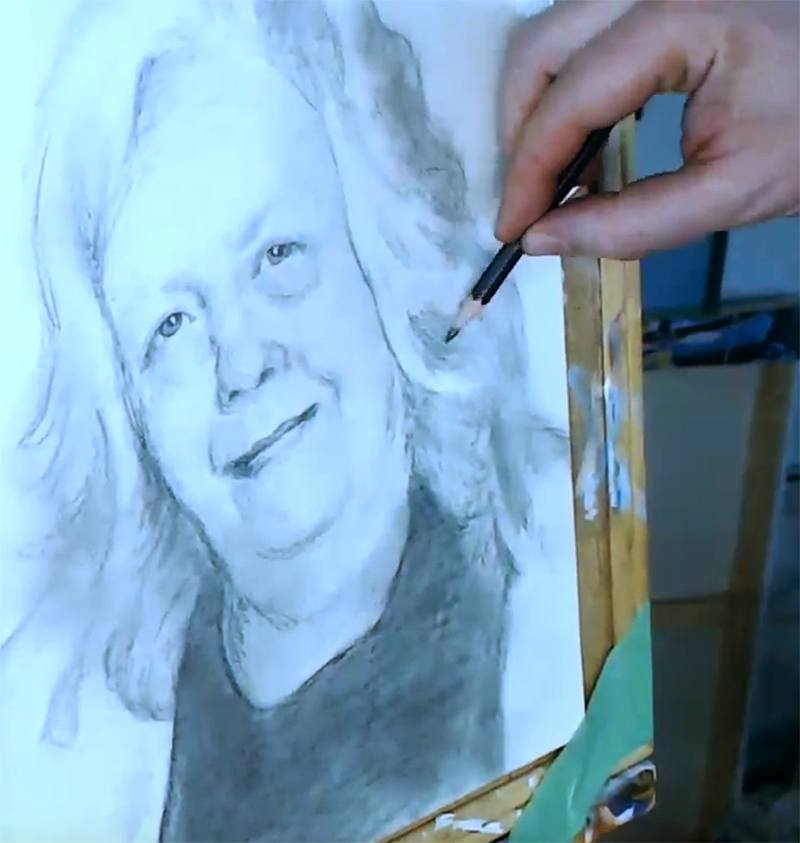
Portrait artist Matt Philleo sketching from a photo
So, why do I have a drawing tutorial here in Realistic Acrylic Portrait School? Because drawing is a fundamental skill, and it will drastically improve your painting. It won’t help to learn advanced skin tone and shading skills unless you know how to see three-dimensional forms and translate them to a two-dimensional surface. You want to be able to see the likeness of the person you’re trying to paint and accurately capture that. Drawing will do this for you faster than anything.
One of my neighbor’s friends’ sister died recently, and she asked me if I could draw a sketch of her to commemorate her. I agreed, and when I had some time in my crazy studio schedule, I got out my paper, and pencils and started sketching.
I set up the photo on my Kindle Fire, right next to my paper and started working. Now this drawing is definitely not fancy since it’s just a sketch done in under an hour, but I try to draw freehand often, to keep my skills sharp. I’m still learning, and trying to improve my skills.
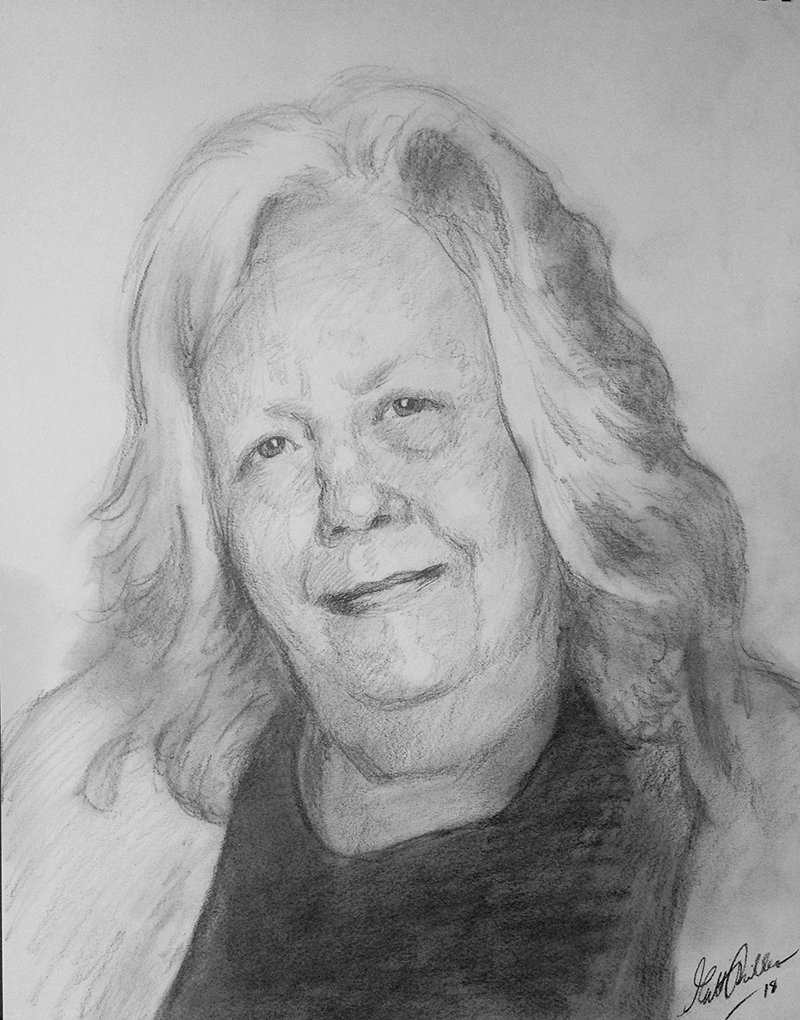
Here is a a free training session showing how I drew the 11″ x 14″ pencil portrait, from start to finish, in about 45-50 minutes. In this video, you will learn:
- How to decide how big to make the face and get the initial proportions
- How to accurately position draw the shape of the features by working loosely at first and getting specific later
- Techniques for shading in the face to give it dimension
- Why it’s important not to blend too much
- And more!
Have a blessed day,

P.S. Did you find this post helpful or encouraging? If so, send it on ahead! Let others know with the share buttons below. I’d love to hear your comments. Thank you so much! Also, do you have a question on acrylic portrait painting you’d like answered? Let me know, and I’d be happy to help!

